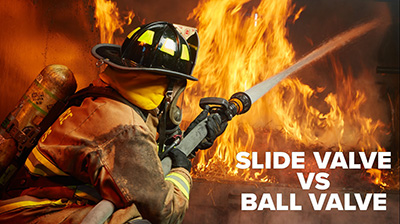Ball Valve vs Slide Valve: Choosing a Valve for Your Nozzles
As a firefighter, one of the decisions you face is selecting the right tools and equipment for the job at hand. When it comes to firefighting nozzles, the type of valve you choose plays a significant role in controlling the flow and quality of your water stream. We often see questions about the differences between ball valves and slide valves.
In this article, we will explore:
- The differences between ball valve and slide valve-equipped nozzles
- The positives and negatives of each choice
- How to make an informed decision based on your firefighting needs
Before we dive in any further, it’s important to remember that each valve type can be used safely and effectively with proper training. As with many equipment choices, the decision on which to use will depend on several factors and may include department preference, the tactics you use on the fire ground, availability of water, or something else entirely.
Ball Valve Nozzles: Efficient and Easy to Use
Let’s start by looking at ball valve nozzles.
These firefighting nozzles utilize a ball inside the nozzle body to turn the water flow on or off. The ball, made of brass, stainless steel, aluminum, or polymer features a central hole that allows water to pass through when the valve is open.

Advantages of a Ball Valve
One of the primary benefits of ball valve nozzles is their low friction loss characteristics when compared to other valve styles. When fully opened, the ball inside the valve moves completely out of the way, making an unobstructed waterway for maximum flow with lower friction loss.
Ball valves also have fewer moving parts than a slide valve which can mean easier maintenance for your crew.
Disadvantages of a Ball Valve
Due to the design, a ball valve is not the best option if you need to gate your flow or limit flow at the nozzle. Ball valves are designed to be fully open. When a ball valve is used to gate your nozzle, it introduces turbulence and can impact the quality of your stream. This is sometimes done intentionally with smooth bore nozzles to create dispersion in the water pattern but does lead to a lowered flow and inconsistent pattern.
Slide Valve Nozzles: Precision and Control
Slide valve nozzles use a different mechanism to regulate the water flow. Inside the nozzle body, the valve mechanism slides back and forth to adjust the flow. This design provides firefighters at the nozzle with enhanced control over the water flow.


Advantages of a Slide Valve
One of the notable advantages of slide valve nozzles is their precision. The sliding valve makes it easy to control your waterflow and target specific areas with focused streams of water. Since the valve is designed to work in multiple positions, there is no negative impact on your water stream. The design does not add turbulence, even when in a half-bail position.
Because of this design, it offers a serious advantage to departments who need to conserve water but want to give the nozzle operator the power to control the flow based on the conditions they face. It also works well for departments using pulsing techniques for atmospheric cooling since it does not add turbulence to the stream.
Disadvantages of a Slide Valve
Slide valve nozzles also come with some disadvantages. To start, the valve itself is a little more complex than a ball valve, which means there are more parts for maintenance and potential repairs.
The design also creates higher friction loss which may or may not be an important factor for your crew.
Choosing the Right Valve for Your Firefighting Needs
When it comes to selecting the appropriate nozzle valve for firefighting operations, it’s crucial to consider your specific needs. Here are some factors to consider:
- Do you need to control your flow at the nozzle or is controlling flow at the pump or through a selectable nozzle adequate for your crew?
- Does your firefighting crew use pulsing techniques or other firefighting techniques that require gating or half-bailing your nozzle?
- Does your response district have an abundant and consistent water supply that limits the need for conserving water?
- How often will your crew train with the nozzles?
- How much time does your department spend maintaining nozzles and other equipment?
